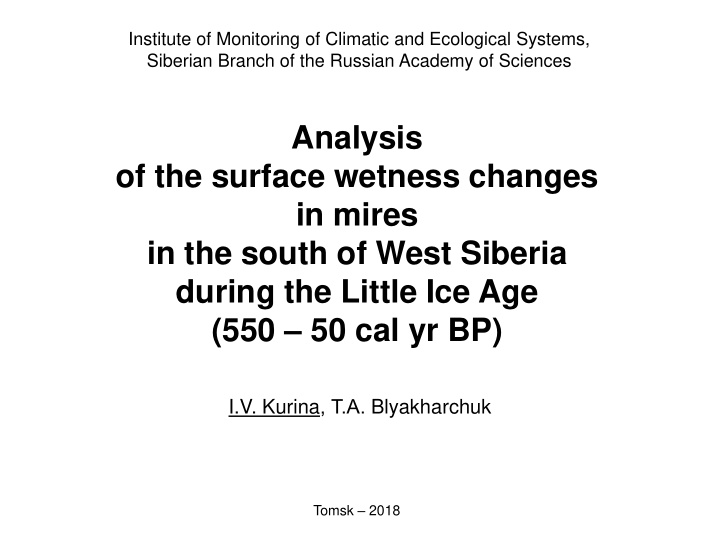



Institute of Monitoring of Climatic and Ecological Systems, Siberian Branch of the Russian Academy of Sciences Analysis of the surface wetness changes in mires in the south of West Siberia during the Little Ice Age (550 – 50 cal yr BP) I.V. Kurina , Т.А. Blyakharchuk Tomsk – 2018
Little Ice Age (LIA) (550 – 50 cal yr BP)
It was cold everywhere during the LIA Dry? However what about the climate humidity ?! Wet?
Goal: • to compare the variations in surface wetness of mires during the Little Ice Age (LIA) in the area of the south of Western Siberia and to contrast with published palaeoclimatic reconstructions.
Study area Taiga
Applied palaeoecological proxies: • Water table depth (DWT) reconstruction (based on testate amoebae analysis) • Annual precipitation reconstruction (based on pollen analysis) • Peat humification (Ih) analysis
Surface wetness changes in mires - Water table depth - Annual precipitation - Peat humification
Southern taiga 600-400 cal yr BP – wet conditions Consistent with: 300-200 cal yr BP - drying Lamentowicz et al., 2015 Willis et al., 2015
Forest-steppe 500-400 cal yr BP – drier conditions Consistent with: 400-300 cal yr BP – wetter conditions Zakh et al., 2010 300 cal yr BP – short-term drying
Mountains (forest belt) 500-400 cal yr BP – wet conditions 300-200 cal yr BP - drying
Study area Taiga
Conclusions: • Heterogeneous surface wetness in mires during the LIA • Spotty trends in wetness dynamics from different zones • Required more objects and higher time- resolution of reconstructions
Thank you for attention !!!
Recommend
More recommend